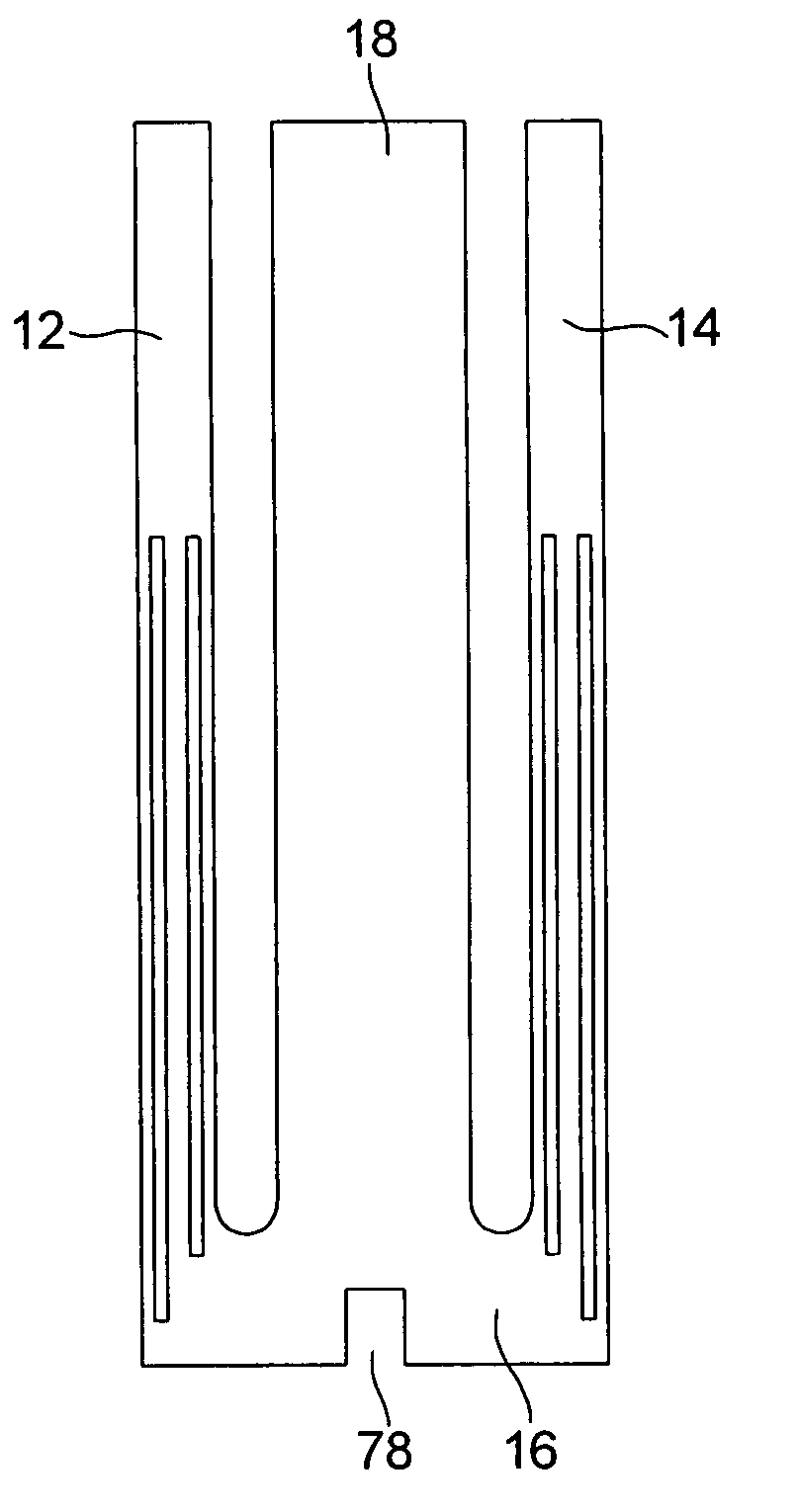Small-sized piezoelectric resonator
a piezoelectric resonator, small technology, applied in piezoelectric/electrostrictive devices, impedence networks, electrical apparatus, etc., can solve the problem that the ratio between the length and the width of the resonator is not very good for the manufacture of such cases, the connection of the resonator and the case to the case is liable to tip towards the bottom of the case, and the resonator and the connection to the case do not have very good shock shock shock
- Summary
- Abstract
- Description
- Claims
- Application Information
AI Technical Summary
Benefits of technology
Problems solved by technology
Method used
Image
Examples
first embodiment
[0037]In the first embodiment shown in relation with FIGS. 1a, 1b and 1c, the resonator according to the invention, designated by the reference numeral 10, includes a tuning fork shaped part with two vibrating arms 12 and 14 joined by a linking part 16 to which a central arm 18, located between arms 12 and 14 and parallel thereto, is attached, the whole assembly being made in a single piece and of quartz.
[0038]As shown by FIGS. 1a and 1b, vibrating arms 12 and 14 carry two groups of electrodes 20 and 22, which are connected to each other by conductive paths respectively 24 and 26, carried by linking part 16 of the tuning fork shaped part. As they are shown in the drawing, these electrodes and conductive paths are disposed to make arms 12 and 14 vibrate in flexure mode, but they could have a different configuration to make the arms vibrate in the same mode or another mode (torsion, shear, etc.). Returning to central arm 18, FIG. 1a shows that it carries on its back face two conductiv...
second embodiment
[0047]One retrieves as for the second embodiment, two variants with decoupling means being located between fixing elements 28 and 30 and linking part 16 to which vibrating arms 12 and 14 are attached. These decoupling means are respectively notches 50 in FIG. 3b and a hole 52 in FIG. 3c. Once again, it will be appreciated that both variants of FIGS. 3b and 3c may be combined.
fourth embodiment
[0048]In the fourth embodiment shown in FIG. 4, the resonator differs from the one shown in FIG. 3a in that in order to guarantee a better mechanical resistance of the resonator in the high stressed areas, exterior grooves 364, respectively 382 which are located on the inside with respect to central arm 18 extend shorter within linking part 16 than interior grooves 362, respectively 384 which are located on the outside with respect to central arm 18. Thus, the quantity of material in the high mechanical stressed areas, which are illustrated by hatched zones 46 and 48 and mainly located in the linking part regions contiguous to vibrating arms 12 and 14, is more important and therefore renders these areas more robust to mechanical constraints.
[0049]In the two variants of the fifth embodiment respectively shown in FIGS. 5a and 5b, the resonator differs from the one shown in relation with FIG. 4 in that fixing and positioning means are arranged on central arm 18. According to this fifth...
PUM
 Login to View More
Login to View More Abstract
Description
Claims
Application Information
 Login to View More
Login to View More - R&D
- Intellectual Property
- Life Sciences
- Materials
- Tech Scout
- Unparalleled Data Quality
- Higher Quality Content
- 60% Fewer Hallucinations
Browse by: Latest US Patents, China's latest patents, Technical Efficacy Thesaurus, Application Domain, Technology Topic, Popular Technical Reports.
© 2025 PatSnap. All rights reserved.Legal|Privacy policy|Modern Slavery Act Transparency Statement|Sitemap|About US| Contact US: help@patsnap.com



